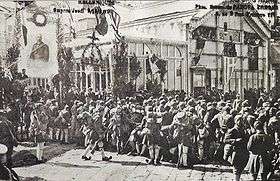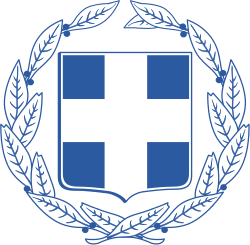Evzones
| Presidential Guard Προεδρική Φρουρά | |
|---|---|
|
Evzone guarding the Tomb of the Unknown Soldier in Athens wearing the full dress uniform | |
| Active | 1833 – present |
| Country |
|
| Branch | Army |
| Type | Foot Guards - Infantry |
| Role |
|
| Size | One battalion |
| Part of |
|
| Garrison/HQ | Athens, Greece ("Camp of Georgios Tzavelas") |
| Nickname(s) | Tsoliades |
| Uniform |
|
| March | Evzonaki |
| Rifle |
|
| Engagements | |
| Website | Official Homepage |
| Commanders | |
| Ceremonial chief | President of the Hellenic Republic |
| Notable commanders | Nikolaos Plastiras |
| Insignia | |
| Shoulder patch |
 |
The Evzones, or Evzoni (Greek: Εύζωνες, Εύζωνοι, pronounced [evˈzones, evˈzoni]), is the name of several historical elite light infantry and mountain units of the Greek Army. Today, it refers to the members of the Presidential Guard (Greek: Προεδρική Φρουρά; Proedrikí Frourá), an elite ceremonial unit that guards the Greek Tomb of the Unknown Soldier (Greek: Μνημείο του Άγνωστου Στρατιώτη; Mnimeío tou Άgnostou Stratiόti), the Presidential Mansion and the gate of Evzones camp in Athens. An Evzone (Greek: Εύζωνας) is also known, colloquially, as a Tsoliás (Greek: Τσολιάς, Τσολιάδες; pl. Tsoliádes).
Though the Presidential Guard is a primarily ceremonial unit, all Evzones are volunteers drawn from the Hellenic Army's Infantry Corps. Prospective Evzones are initially identified at the Infantry Recruit Training Centres during Basic Training; there is a minimum height requirement of 1.87 m (6' 1.3") to join.
The unit is known for its uniform, which has evolved from the clothes worn by the klephts[1] who fought the Ottoman occupation of Greece. The most visible item of this uniform is the fustanella, a kilt-like garment. Their distinctive dress turned them into a popular image for the Greek soldier, especially among foreigners.
Etymology
The word evzōnos (Greek: εὔζωνος[2]) is first attested in Homer's Iliad and derives from εὖ and ζώνη, meaning "well-girt". The word was used by ancient writers for centuries to describe a type of light infantry of unidentified equipment, probably used as a generic term to denote light infantry.
History
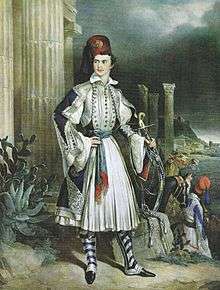
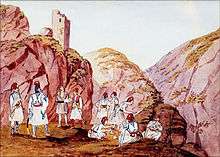


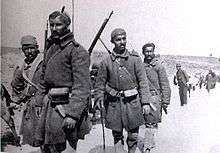
In 1833, after the arrival of King Otto, the Greek Army was organized along new lines. The Bavarian soldiers that had come with Otto formed the majority of the "European" Line Infantry battalions (Greek: Τάγματα Γραμμής; Tágmata Grammís). Each of these units included one rifle company, designated as "Skirmishers" (Greek: Λόχος Ακροβολιστών; Lókhos Akrovolistón) or "Evzone" (Greek: Λόχος Ευζώνων; Lókhos Evzónon). In addition, ten light "Skirmisher" battalions (Greek: Τάγματα Ακροβολιστών; Tágmata Akrovolistón) were formed from Greeks, dressed in a uniform based on the garb of the klephts of the War of Independence (1821–1829). In 1836 these battalions were reduced to four, and eight "Mountain Guard" battalions (Greek: Τάγματα Οροφυλακής; Tágmata Orofylakís) were formed in their stead; they were grouped into four regiments in 1843. These units were primarily engaged in patrolling the frontier, combating insurgents and hunting down the many brigands that infested the countryside. The Mountain Guard was incorporated in the strengthened "Skirmisher" battalions in 1854.
In December 1867, the first four elite "Evzone" light battalions were formed, of four companies each (soon expanded to five), with the task of guarding the frontier. On 12 December 1868, the Royal Guard detachment, initially named Agema (Άγημα), later the Palace Guard (Ανακτορική Φρουρά; Anaktorikí Frourá), composed of two Evzone infantry companies and a cavalry troop, was formed. In 1880-1881, the Evzone units were expanded to nine battalions. They participated in the disastrous 1897 war with Turkey as elements of the regular infantry divisions. In the aftermath of the war, through various reorganizations, the number of Evzone battalions varied from eight to six, operating either independently or divided between the infantry divisions, and were among the first units to be equipped with machine guns. At the time of the Balkan Wars, eight Evzone battalions were in existence. They operated independently on the vanguard or the flanks of the army. They distinguished themselves for their fighting spirit suffering high casualties, especially among officers. Subsequently the Evzone units were increased to five regiments, which fought with distinction as elite shock troops in the First World War, the Asia Minor Campaign and the Greco-Italian War.
During the German invasion in 1941, a memorable event is said to have occurred: on April 27, as the German Army was entering Athens, the Germans ascended to the Acropolis of Athens and ordered the young Evzone who was guarding the flag post, Konstantinos Koukidis (q.v.), to haul the Greek flag down and replace it with the swastika flag. The young soldier did so, but refused to hand over the Greek flag to the Germans, and instead wrapped himself in it and fell off the Acropolis to his death.
After the occupation of the country, in 1943, the collaborationist government raised a number of "Security Battalions" (Τάγματα Ασφαλείας), which were dressed in the Evzone uniform and participated in operations against the EAM-ELAS partisans.[3] They were derisively known as Germanotsoliades ("German Evzones") or Tagmatasfalites ("Security Battalionists"), and were disbanded after liberation in 1944.
After the war, the reconstituted Hellenic Army did not re-establish the Evzone regiments, their elite status and role being assumed by the newly established Mountain Raiding Companies. The traditions and distinctions of the Evzones are, however, maintained by a special ceremonial unit, which has served under several names: Palace Guard (Greek: Ανακτορική Φρουρά), Flag Guard (Greek: Φρουρά Σημαίας), Tomb of the Unknown Soldier Guard (Greek: Φρουρά Μνημείου Αγνώστου Στρατιώτη), Royal Guard (Greek: Βασιλική Φρουρά) and after 1974, with the abolition of the monarchy, the Presidential Guard (Greek: Προεδρική Φρουρά). Several regular Army Infantry units have been given the numbers and names of the post-1913 Evzone Regiments, however, these names are only honorific.
Present
Today the Evzones form the Presidential Guard, a battalion composed of 2 Evzone companies and 1 command company. They operate out of the Georgios Tzavelas barracks (named to honor Georgios Tzavelas, a chieftain and hero of the Greek Revolution of 1821) on Herodou Attikou Street, just behind the Parliament building.
The Guard takes precedence in all military parades. Their march style consists of normal march time, and at intervals, for several paces, striking the ground forcefully with the right foot. Their standard marching music is the "Evzonaki" ("little Evzone") (Greek: Ευζωνάκι) march, played at 48 beats/min. They guard the Tomb of the Unknown Soldier round the clock. Guards on duty perform their movements in a very slow and highly stylized manner. They switch positions with each other every fifteen minutes and remain completely motionless and at attention in the meantime. Since the Guards are required to be totally still at all times, there is one Evzone in normal fatigues uniform and police surveillance to ensure that no one approaches or harasses the Guards while on duty. The "little changes" take place every hour on the hour, and involve the two incoming and two outgoing sentries, and a supervising "Corporal of the Change". The Grand Change takes place at 11 am on Sunday mornings, and involves the whole Guard with its officers and a military band, all marching from the Guard Barracks to the Tomb for the Change, and back. The Grand Change is a popular Sunday morning spectacle for Athenians and tourists alike.
During a demonstration in front of the Parliament in 2001, a Molotov cocktail was thrown at one of the guardhouses. The wooden construction was engulfed in flames. The Evzone on guard next to it remained in place until an officer gave him the order to move. With a scorched and partly smoking uniform on one side, the Evzone did so.[4]
In January 2010, a makeshift bomb was placed 20 meters from where the Evzones guard the Tomb of the Unknown Soldier, at Syntagma Square. Although the police informed the Evzones of the imminent threat, the Guards refused to leave their posts and remained on guard while the bomb exploded.[5][6]
Former units
The historical units were numbered and known as Τάγμα Ευζώνων ("Evzone Battalion") or Σύνταγμα Ευζώνων ("Evzone Regiment"). The first Evzone Regiment was formed in 1912, shortly before the outbreak of the Balkan Wars. The "traditional" and well-known Evzone regiments, which fought in World War I, the Asia Minor Campaign, and World War II, were formed after the Balkan Wars by the Royal Decree of 23 December 1913. Since the regiments were distinctive, elite units, they had dual numbers—the first, numbering them in the Evzones order of seniority, the second, in the overall infantry hierarchy. Thus the 5/42 Evzone Regiment was the 5th Evzone regiment, but also the 42nd infantry regiment.
- 1/38 Evzone Regiment, the former 1st Evzone Regiment, based in Karditsa and recruited in Thessaly
- 2/39 Evzone Regiment, based in Missolonghi and recruited in Aetolia-Acarnania
- 3/40 Evzone Regiment, based in Arta and recruited in Epirus
- 4/41 Evzone Regiment, based in Veroia and recruited in western Macedonia
- 5/42 Evzone Regiment, based in Lamia and recruited in Central Greece
Uniform
In 1833, the uniform of the Evzones (as in all infantry companies of the line battalions) was in the unpopular Bavarian style of blue trousers, tailcoats and shako. As light infantry the Evzones were distinguished only by green braid and plumes. In 1837, a new uniform was created based on the traditional fustanella style worn by the klephts, armatoli, and many of the famous fighters of the Greek War of Independence. At first, it was only issued to the native light infantry battalions, but its popularity led to its adoption as the official uniform of the Evzones in 1867. After a few minor changes over the years, it became the familiar uniform seen today.
Present-day uniforms
Ceremonial uniforms
The present-day ceremonial uniform consists of the following items:
- Farion (φάριον), a scarlet fez with a long black silk tassel, with the national emblem on the front.
- Doulamas (plural: doulamades) (ντουλαμάς, plural: ντουλαμάδες), a long tunic which is the everyday uniform. There are winter and summer versions. The basic color of the winter doulamas is navy blue and it closely resembles the service uniform worn until 1910, while the summer version is light khaki, and similar in design to the field uniform adopted by the Evzone regiments after that date.
- Foustanella (φουστανέλα), a cotton kilt made from 30 meters (98 feet) of white cloth, with supposedly 400 pleats (Greek: πιέτες) representing the 400 years of Ottoman occupation.[1] The foustanella derives from the traditional uniform of Continental Greece.
- Ypodetes (υποδήτης), a white shirt with very wide sleeves.
- Fermeli (φέρμελη), the waistcoat. Various traditional designs are embroidered on it in white or gilt thread. The yellow stripes (if any) indicate the military rank of the wearer. Sergeants have two stripes and corporals have one.
- Krossia (κρόσσια), fringes in blue and white, the colors of the Greek flag.
- Epiknemides (επικνημίδες), unofficially called kaltsodetes (καλτσοδέτες), the garters. They are made of black silk.
- Periskelides (περισκελίδες), white woollen stockings, two on each leg.
- Anaspastos (Greek: ανάσπαστος), inside garter which holds the periskelides in position.
- Tsarouchia (τσαρούχια, singular: τσαρούχι), red leather clogs with black pompons (φούντες, foundes; singular: φούντα, founda). Under the sole, depending on the size, there are 60 to 120 nails. On average each tsarouchi weighs approximately 1.5 kilos (3.5 pounds).
- A black leather cartridge belt which has a bayonet belt holder case.
- When it is very cold the Evzones wear a dark blue cape (κάπα). This was formerly part of the field uniform until replaced by a khaki version in 1910.
They are armed with a M1 Garand semi-automatic rifle, with bayonet.
Everyday uniform consists of the farion, doulamas, stockings, garters, and tsarouchia. Formal dress, which is worn on Sundays, on important national holidays, at the reception of foreign dignitaries and on other special occasions, consists of the farion, ypodetes, foustanela, fermeli, krossia, stockings, garters and tsarouchia.
The first king of modern Greece, Otto, often wore this uniform in public. Today, many Greek boys dress up as tsoliades on Greek Independence Day.[1]
Island and Pontic variants

Members of the Guard can also sometimes be seen in a royal blue and red uniform based on the traditional male costume of the Aegean Islands or in a uniform based on the black traditional habit once worn by the Pontic Greeks. These variants are worn on ceremonial occasions where there is a requirement for Evzones to undertake "unarmed" duties (such as flag-raising ceremonies, commemorations), usually alongside armed Evzones dressed in the formal ceremonial uniform.
While predominantly Cretan in origin - it is sometimes, incorrectly, called the Cretan Uniform (Greek: Κρητική Στολή; Kritikí Stolí) - the Island Uniform (Greek: Νησιωτική Στολή; Nisiotikí Stolí) incorporates elements from various costumes of the Aegean Islands. It consists of a tassel-less fez (Greek: φάριον; fárion), Cretan-style coat in blue with a red vest and white shirt, the distinctive blue islander breeches (Greek: βράκα; vráka), Cretan-style belt with a Cretan knife and white leather thigh-high boots (Greek: στιβάνια, stivánia). An Evzone wearing the Island uniform is also called a Vrakofόros (Greek: Bρακοφόρος, literally a "wearer of breeches").
The Pontic Uniform (Greek: Ποντιακή Στολή; Pontiakí Stolí) is only worn on May 19, in commemoration of the Greek Genocide.
Officers' uniform
The uniform of the officers is closer to the original dress worn by the klephts. Its main differences are the longer foustanella, the more elaborate fermeli in tyrian purple with gold embroidery, whose sleeves are worn closed on the arms instead of being fastened to the coat, red-and-gold gaiters (τουζλούκια; touzloúkia) that cover the whole lower leg worn over red trousers, and red boots (Greek: σταβάλια; stavália). Their rank is indicated below the national emblem on the farion, and they are armed with a pála, a kilij-style sword.
The uniforms (of the officers and the soldiers) are completely handmade. They are sewn and maintained by civilian personnel of the Presidential Guard in workshops in the camp.
Service uniform
The Evzones wear the regular Hellenic Army uniform when not in guard service. They are distinguished from the other Army units by an azure beret and blue embroidered patches on the shoulders which have white letters that form the words: ΠΡΟΕΔΡΙΚΗ ΦΡΟΥΡΑ (Proedriki Froura, "Presidential Guard").
Notable Evzones
- Emmanouil Zymvrakakis
- Ioannis Velissariou
- Dimitrios Psarros
- Christodoulos Tsigantes
- Thrasyvoulos Tsakalotos
- Paul of Greece
- Prince Peter of Greece and Denmark
- Konstantinos Koukidis
- Vangelis Meimarakis
- Stelios Manolas
- Nikos Zisis
- Kostas Sloukas
- Nikos Pappas
References
- 1 2 3
- ↑ εὔζωνος, Georg Autenrieth, A Homeric Dictionary, on Perseus
- ↑ Thomas, Nigel. Partisan Warfare 1941-45. p. 38. ISBN 0-85045-513-8.
- ↑ Evzones - Athens Info Guide
- ↑ Kathimerini, Tuesday, January 12, 2010
- ↑ Kathimerini, Monday, January 11, 2010
Further reading
In English
- Mylonas, Yannis (1997). Paxinou, Barbara, ed. The Evzones. Strategic Publishing. p. 332. ISBN 9607178416.
In Greek
- Μυλωνάς, Γιάννης (1998). ΟΙ ΕΥΖΩΝΟΙ [The Evzones]. Athens: Στρατηγικές Εκδόσεις. p. 331. ISBN 960-7178-39-4.
- Κολόμβας, Νικόλαος (2009). 2/39 Σύνταγμα Ευζώνων. Σελίδες από την πολεμική ιστορία του. [2/39 Evzone Regiment. Pages from its war history.] (2nd ed.). Αιτωλική Πολιτιστική Εταιρεία (ΑΙ.ΠΟ.Ε).
- Αλεξόπουλος, Σωτήρης (2012). Το Ημερολόγιο του Εύζωνα Χρήστου Δ. Αλεξόπουλου [The Diary of the Evzone Christos D. Alexopoulos]. Kavala: Ξυράφι. p. 267. ISBN 978-960-89430-6-3.
External links
| Wikimedia Commons has media related to Evzones. |
- Greek Presidency
- Historical Photographs at Βικιπαίδεια
- Athens Info Guide
- Athens In Pictures
- BootsnAll
- great travel pictures
- Article of newspaper Ethnos about the Evzones uniform (Greek)
- Article of newspaper Ethnos about the Evzones (Greek)
- "Meet the 'unflinching' Greek Presidential Guard"- BBC News feature
